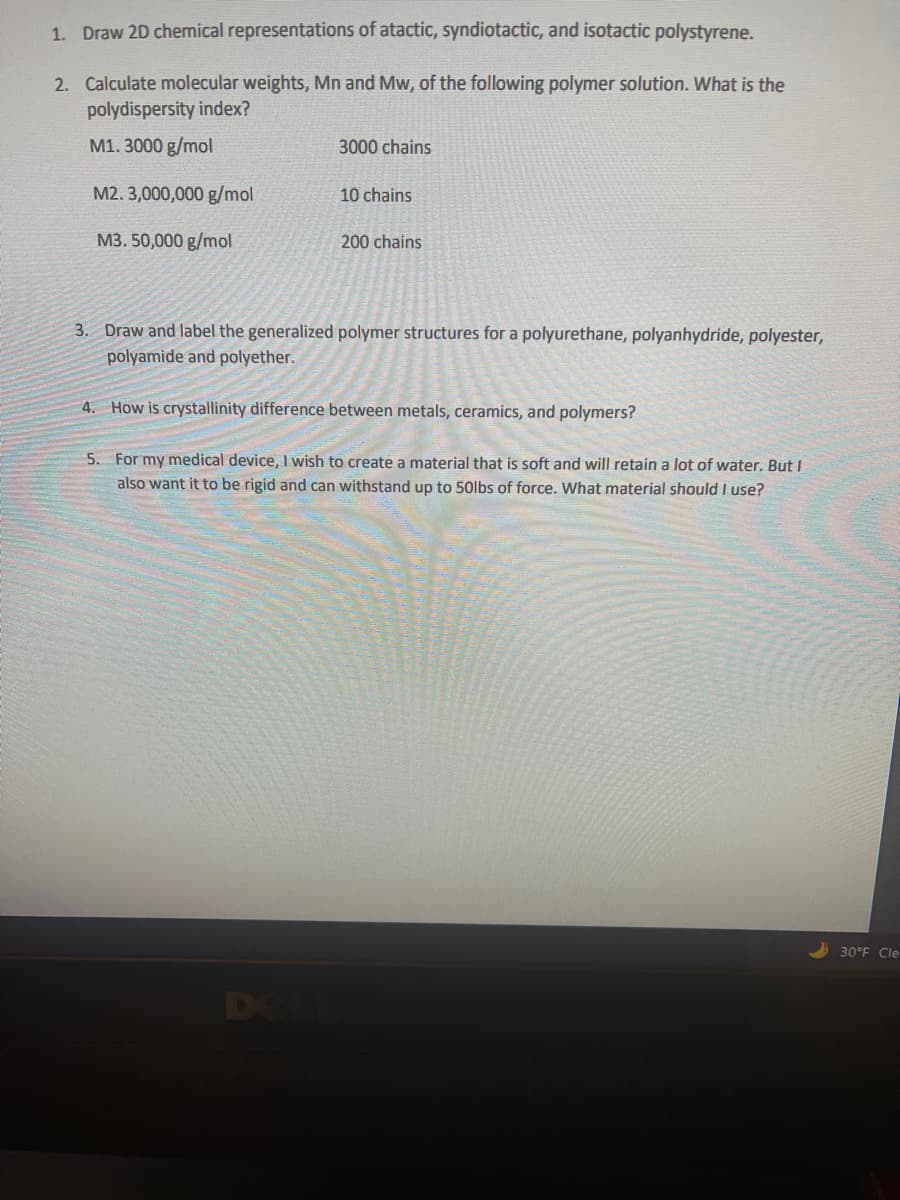1. Draw 2D chemical representations of atactic, syndiotactic, and isotactic polystyrene. 2. Calculate molecular weights, Mn and Mw, of the following polymer solution. What is the polydispersity index? M1. 3000 g/mol 3000 chains M2. 3,000,000 g/mol 10 chains M3. 50,000 g/mol 200 chains 3. Draw and label the generalized polymer structures for a polyurethane, polyanhydride, polyester, polyamide and polyether.
1. Draw 2D chemical representations of atactic, syndiotactic, and isotactic polystyrene. 2. Calculate molecular weights, Mn and Mw, of the following polymer solution. What is the polydispersity index? M1. 3000 g/mol 3000 chains M2. 3,000,000 g/mol 10 chains M3. 50,000 g/mol 200 chains 3. Draw and label the generalized polymer structures for a polyurethane, polyanhydride, polyester, polyamide and polyether.
Chapter31: Synthetic Polymers
Section31.SE: Something Extra
Problem 21AP
Related questions
Question
100%

Transcribed Image Text:1. Draw 2D chemical representations of atactic, syndiotactic, and isotactic polystyrene.
2. Calculate molecular weights, Mn and Mw, of the following polymer solution. What is the
polydispersity index?
M1. 3000 g/mol
3000 chains
M2. 3,000,000 g/mol
10 chains
M3. 50,000 g/mol
200 chains
3. Draw and label the generalized polymer structures for a polyurethane, polyanhydride, polyester,
polyamide and polyether.
4. How is crystallinity difference between metals, ceramics, and polymers?
5. For my medical device, I wish to create a material that is soft and will retain a lot of water. But I
also want it to be rigid and can withstand up to 50lbs of force. What material should I use?
30°F Cle
DO
Expert Solution
Step 1
First three question answered below:
Trending now
This is a popular solution!
Step by step
Solved in 4 steps with 3 images

Knowledge Booster
Learn more about
Need a deep-dive on the concept behind this application? Look no further. Learn more about this topic, chemistry and related others by exploring similar questions and additional content below.Recommended textbooks for you


Organic Chemistry
Chemistry
ISBN:
9781305580350
Author:
William H. Brown, Brent L. Iverson, Eric Anslyn, Christopher S. Foote
Publisher:
Cengage Learning

Principles of Modern Chemistry
Chemistry
ISBN:
9781305079113
Author:
David W. Oxtoby, H. Pat Gillis, Laurie J. Butler
Publisher:
Cengage Learning


Organic Chemistry
Chemistry
ISBN:
9781305580350
Author:
William H. Brown, Brent L. Iverson, Eric Anslyn, Christopher S. Foote
Publisher:
Cengage Learning

Principles of Modern Chemistry
Chemistry
ISBN:
9781305079113
Author:
David W. Oxtoby, H. Pat Gillis, Laurie J. Butler
Publisher:
Cengage Learning

Chemistry & Chemical Reactivity
Chemistry
ISBN:
9781337399074
Author:
John C. Kotz, Paul M. Treichel, John Townsend, David Treichel
Publisher:
Cengage Learning

Chemistry: An Atoms First Approach
Chemistry
ISBN:
9781305079243
Author:
Steven S. Zumdahl, Susan A. Zumdahl
Publisher:
Cengage Learning

Chemistry
Chemistry
ISBN:
9781305957404
Author:
Steven S. Zumdahl, Susan A. Zumdahl, Donald J. DeCoste
Publisher:
Cengage Learning